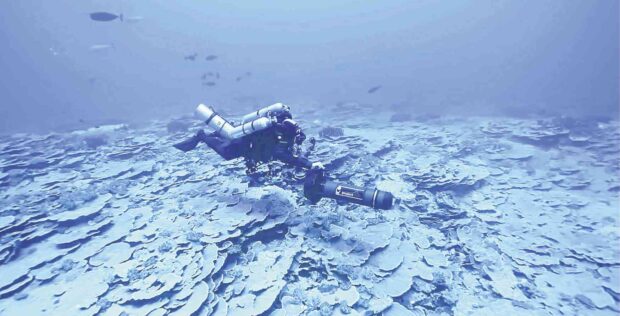Seabed mining: Lack of checks keeps PH blind to lasting harm

SCIENTIFIC RESEARCH | A diver explores the seabed of Benham Rise believed to be rich in marine resources and underwater minerals. (INQUIRER FILE PHOTO)
MANILA, Philippines — A maritime expert said the government should enact strict laws to regulate the mining of the seabed, amid an increase in this activity which threatens the country’s marine ecosystem.
“What is happening [now] is seabed mining but near [the] shore. And it’s very destructive because it’s … usually also where fishing grounds are,” Jay Batongbacal, director of the University of the Philippines’ Institute for Maritime Affairs and Law of the Sea, told the Inquirer in a recent phone interview.
He said the country has no “developed regulations” for these mining ventures and is left with only “vague” measures.
“If they can’t even regulate [mining close to shore], what more if they (companies) move to deeper waters? The Philippines might end up submerged,” he warned.
‘Short-term interests’
Batongbacal cited the case of Lingayen Gulf, a major fishing ground and an environmentally critical area along the coastal provinces of Pangasinan and La Union.
He said the gulf has become the site of a massive black sand mining project approved in 2020 by the previous administration of Rodrigo Duterte.
“In the case of Lingayen Gulf, it is also already an overexploited aquaculture area. [So] the seabed mining activity there would definitely [cause further] adverse environmental impact,” Batongbacal said.
One project approved by the government in 2020 was the large-scale exploration, development, and commercial use of minerals found in those waters under a Financial or Technical Assistance Agreement (FTAA) between the government and Iron Ore, Gold and Vanadium Resources Phils. Inc.
The communities that may be affected by that project, together with marine experts and environmental groups, have expressed their opposition to that agreement under which 25 million tons of black sand would be extracted annually for 25 years.
The University of the Philippines Marine Science Institute (UPMSI) said the project “will only serve the short-term interests of those who will profit from a misguided development that threatens the lifeblood of Pangasinan and La Union.”
It added: “The negative impacts on natural resources, coastal communities and their livelihood, and even on tourism may last beyond the life of the project, and could be irreversible.”
Other applications
UPMSI said Lingayen Gulf is home to several marine protected areas and a national park. About 40 species, including milkfish (“bangus”), mackerel (“alumahan,” or “hasa-hasa”), roundscad (“galunggong”), rabbitfish (“barangen”) are found in the area.
More than a million residents live along the gulf’s coast, about 47,000 of whom are engaged in fishing.
In April 2021, Duterte issued Executive Order No. 130, which lifted a ban on new mining permits imposed in 2012 by the administration of his predecessor Benigno Aquino III. The new order was aimed at promoting investments to help the country recover from the COVID-19 pandemic.
According to records from the Mines and Geosciences Bureau, two more FTAA applications followed—one for Hong Kong-based Ferro Resources Corp. and another for Pangasinan Ferro Resources Corp.
An earlier application for FTAA filed in 2010 by Altamina Exploration Resources Inc. will expire in 2035. An estimated 9,588 hectares of coastal areas are intended to be mined under that project.
Distant possibility
Despite the growing threat of offshore mining, Batongbacal said deep seabed mining is still a distant possibility since the technology for it is not yet developed here.
“I see the feasibility of seabed mining probably still a few decades away,” he said. “As to the technology that is being developed, it is still in the infan[cy] stages. Many of them are still experimental.”
Nevertheless, he and other advocates for the protection of the sea warned that without a law on seabed mining, the exploitation of maritime resources will be left unchecked.